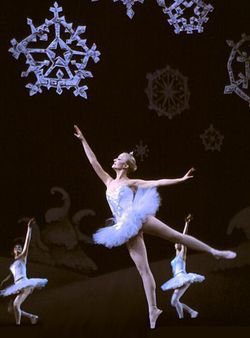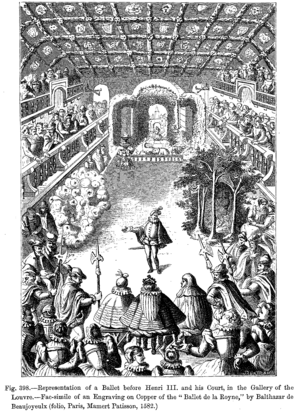| |
Ballet
Music Sound
Ballet
Choreography | Ballet (music) | Opera ballet
 The Waltz of the Snowflakes from
Tchaikovsky's The Nutcracker.
The Waltz of the Snowflakes from
Tchaikovsky's The Nutcracker.
Ballet is the name given to a specific
dance form and
technique. Works of dance
choreographed using this technique are called ballets, and may
include: dance,
mime, acting and
music (orchestral
and sung).
Ballets can be performed alone or as part of an
opera. Ballet is best known for its
virtuoso techniques such as pointe work, grand pas de deux and high leg
extensions. Many ballet techniques bear a striking similarity to fencing
positions and footwork, perhaps due to their development during the same periods
of history, but more likely, because both arts had similar requirements in terms
of balance and movement.
Domenico da Piacenza (1390..1470) is credited with the first use of the term
ballo (in De Arte Saltandi et Choreas Ducendi) instead of danza
(dance) for his baletti or balli which later came to be known as
Ballets. The first Ballet per se is considered to be
Balthasar de Beaujoyeulx's Ballet Comique de la Royne (1581) and was a ballet
comique (ballet drama). 1581 also saw the publication of Fabritio Caroso's Il Ballarino, a technical manual on ballet dancing
that helped to establish
Italy as a major
centre of ballet development.
History of ballet
 Engraving of a Ballet before
Henri III and his Court, in the Gallery of the Louvre. (folio,
Paris, Mamert Patisson, 1582.)
Engraving of a Ballet before
Henri III and his Court, in the Gallery of the Louvre. (folio,
Paris, Mamert Patisson, 1582.)
Ballet has its roots in
Renaissance court spectacle in
Italy, but was particularly shaped by the French ballet de cour, which consisted
of social dances performed by the nobility in tandem with music, speech, verse,
song, pageant, decor and costume. Ballet began to develop as a separate art form
in France during the reign of Louis XIV, who was passionate about dance and
determined to reverse a decline in dance standards that began in the 17th
century. The king established the Académie Royale de Danse in 1661, the same
year in which the first comédie-ballet, composed by Jean-Baptist Lully was performed. This early form consisted of a play in
which the scenes were separated by dances. Lully soon branched out into opéra-ballet,
and a school to train professional dancers was attached to the Académie Royale
de Musique, where instruction was based on noble deportment and manners.
The 18th Century was a period of vast advancement in the technical standards
of ballet and the period when ballet became a serious dramatic art form on par
with the Opera. Central to this advance was the seminal work of Jean-Georges
Noverre, Lettres sur la danse et les ballets (1760), which focused on developing
the ballet d'action, in which the movements of the dancers are designed to
express character and assist in the narrative. Reforms were also being made in
ballet composition by composers such as Christoph Gluck. Finally, ballet was divided into three formal techniques
sérieux, demi-caractère and comique. Ballet also came to be
featured in operas as interludes called divertissements.
The 19th Century was a period of great social change, which was reflected in
ballet by a shift away from the aristocratic sensibilities that had dominated
earlier periods through Romantic ballet. Ballerinas such as Marie Taglioni and
Fanny Elssler pioneered new techniques such as pointework that rocketed the
ballerina into prominence as the ideal stage figure, professional librettists
began crafting the stories in ballets, and teachers like Carlo Blasis codified
ballet technique in the basic form that is still used today. Ballet began to
decline after 1850 in most parts of the western world, but remained vital in
Denmark and, most notably, Russia thanks to masters such as August Bournonville,
Jules Perrot and Marius Petipa. Russian companies, particularly after World War
II engaged in multiple tours all over the world that revitalized ballet
in the west and made it a form of entertainment embraced by the general public.
It is one of the most well preserved dances in the world.
Ballet education
Canada
Denmark
-
[1] Royal Danish Ballet School, Copenhagen
-
[2] Royal Danish Ballet School, Holstebro
-
[3] Royal Danish Ballet School, Odense
Germany
Hong Kong
Russia
Switzerland
United Kingdom
USA
-
North Carolina School of the Arts Located in Winston-Salem, North
Carolina
-
School of American Ballet Official ballet school of the
New York City Ballet, founded by George Balanchine and Lincoln Kirstein
-
Jacqueline Kennedy Onassis School Official Ballet School of
American Ballet Theatre, located in New York City.
-
Houston Ballet Academy Official school of Houston Ballet, located in
Houston, Texas.
-
The Washington School of Ballet Located in the nation's capital,
Washington, District of Columbia or Washington, DC.
-
The San Francisco Ballet School
-
The Pacific Northwest Ballet School Located in Seattle, Washington.
-
The School of Oregon Ballet Theatre Located in Portland, Oregon
-
The Central Pennsylvannia Youth Ballet Located in Carlisle,
-
The Rock School for Dance Education Located in Philadelphia,
Pennsylvannia
-
Boston Ballet and Boston Ballet School Located in Boston, Massachusetts
-
Chicago Festival Ballet Located in
Naperville, IL and
Joliet,
IL in the suburbs of
Chicago, Illinois
-
Miami City Ballet Company and School located in Miami, Florida.
-
Midland Festival Ballet Located in Midland, Texas,
-
Ballet Hawaii Located in Honolulu, Hawaii
- Class Act Dance Studio, Located in Clyde, Ohio. See
[9]
- Jan's Dance Academy, Located in Orange Park, Florida
Australia
-
Australian Ballet School
[10]. 95 % of the
Australian Ballet Company are graduates from this school.
-
Perth City Ballet 100% of Perth City Ballet Members are graduates from
this school.
[[ ==
Norway
-
Statens Balletthøgskole (Norwegian National College of Ballet and Dance)
[11]
See also
External links
Video clips
Home | Up | List of musical forms | Ballet | Concertos | Dances | Gendhing | Opera | Operetta | Sonatas | Song forms | Aleatoric music | Arch form | Bagatelle | Ballad | Ballade | Ballet | Bar form | Barcarolle | Binary form
Music Sound, v. 2.0, by MultiMedia
This guide is licensed under the GNU
Free Documentation License. It uses material from the Wikipedia.
|
|







